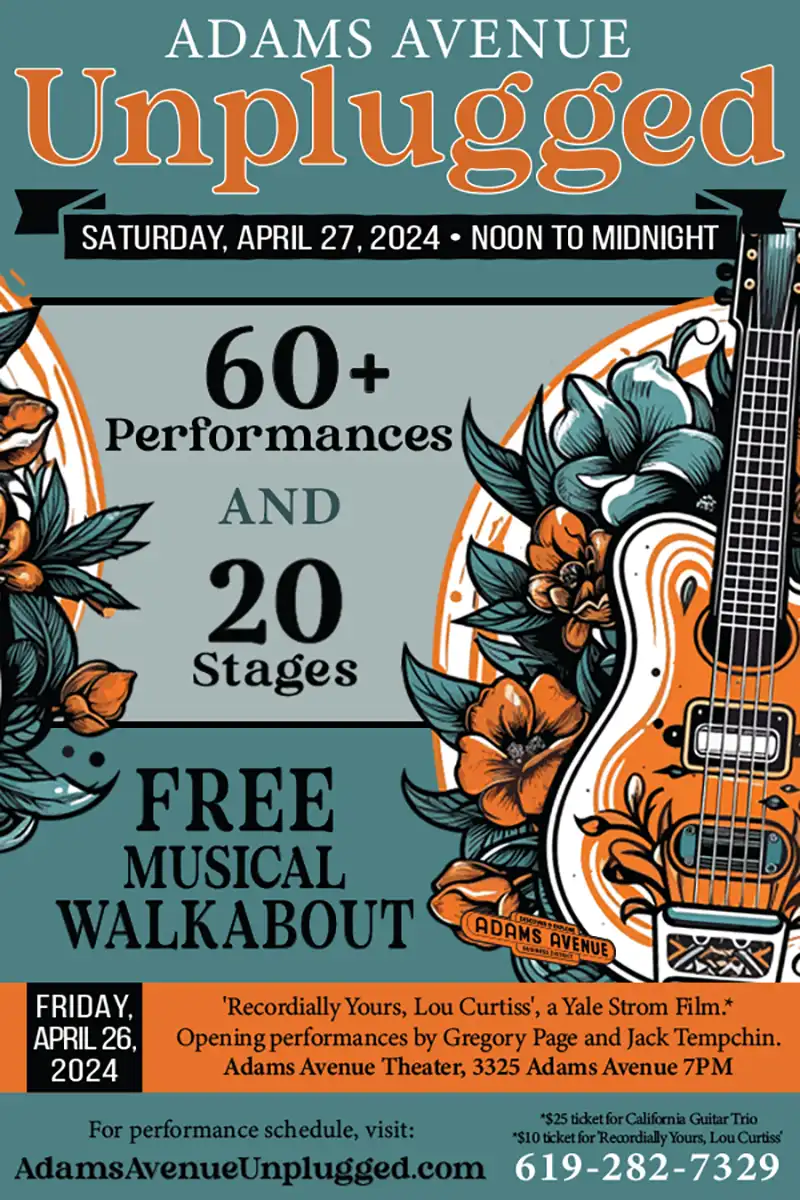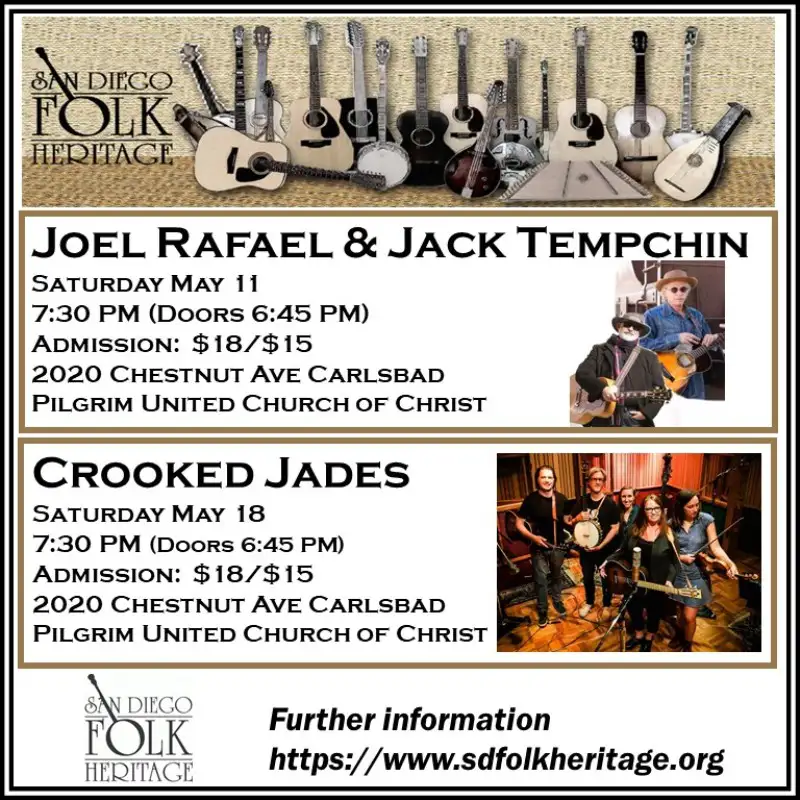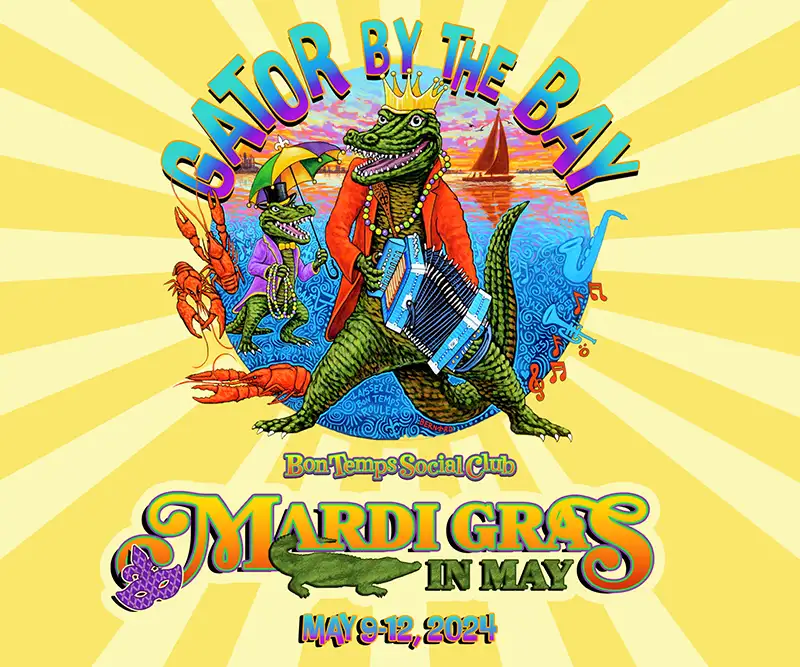Cover Story
The Perpetual Flowering of DAVID FLEMINGER
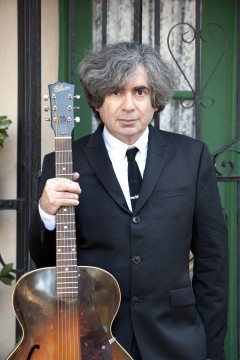
David Fleminger. Photo by Steve Covault.
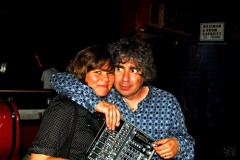
Fleminger with his wife, Heather Vorwerck
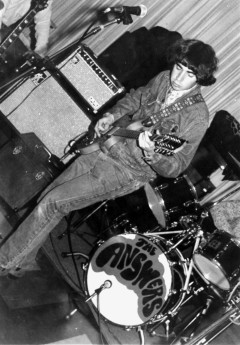
Fleminger in the Answers, 1980s
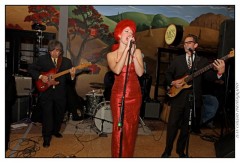
The Amandas with Fleminger (left)
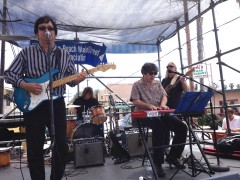
True Stories (Bart Mendoza/Danny Cress, Fleminger, Billy Fritz)
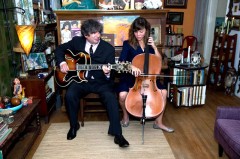
David and Heather in the Comeuppance
Meet David Fleminger. A soft spoken, 1,000-petaled lotus of artistic temperament whose place amongst San Diego music history is secure, based on the numerous groundbreaking bands he has been involved with over the years. Although he spent half of his life 550 miles north of here, in San Francisco, he found out in 2011 that sometimes you can indeed return home again — in this case, San Diego.
Fleminger was born on February 4, 1964 at Sharp Hospital, “right behind the big stork,” he says. As an only child with no siblings for company or rivalry (“just invisible friends,” he quips), he grew up in San Diego after his father became employed at Scripps Institute of Oceanography as a marine biologist and a teacher. Fleminger says that he “definitely inherited” his father’s love for the natural world. “I’m a huge appreciator of nature,” he says. “I try to embody that observation technique in art and painting and things like that. I think I find that connection there, and on the science side I apply that to concepts of musical technique, creation, and composition. And definitely, once I started using the computer and tied it into music, I got used to that scientific framework for composing, because it’s a great organizational tool. I was heavily into doing sampling and doing computer sequencing and I worked in toy audio — audio for toy design and that was very computer centric because everything was about getting information onto little, tiny chips.”
Before he started formal schooling Fleminger was already being encouraged by his parents to play the piano. “I started out when I was five or six and I played up until the mid-’70s — I was pretty hot and heavy on it. I did some competitions, solo piano recitals. I did the Chopin-Schumann festival in ’74.”
But an incident at summer camp in Santa Cruz at the age of 13 caused him to shift his musical allegiance to the guitar. “This may sound really silly but when I was at summer camp in ’77 or ’78 there was this talent show where I was going to be playing some Beatles songs on the piano and I had this dream the night before where all of a sudden the Beatles were there to perform and I’m there on stage with them with a guitar in my hand and I had never played guitar before and in my dream I could do it and I was really, really rocking and it went over really well. And after that dream I was, ‘oh, I gotta play guitar,’ and from that point on I was obsessed about playing guitar and the piano pretty much fell out the window.”
THE AGE OF ENLIGHTENMENT AND/OR ARRESTED DEVELOPMENT
“Before I met Bart [Mendoza] and Kevin [Ring] and joined Manual Scan I was actually in a couple of other bands with friends from Clairemont High (class of ’82). The first gigging band I was in was called Adolescent Behavior with my friend Dave Doyle, who became the bass player in the Unknowns and who put out an amazing EP on Sire in ’81 called Dream Sequence, and an LP (The Unknowns) on Invasion.
“We were called Adolescent Behavior probably because the only Skeleton Club show that I ever got to see was the Mature Adults with the Go-Go’s and the Alley Cats. The Skeleton Club was on Market Street and I think it was one of the last shows before the police shut them down. And from that show I became aware of this incredible scene going on in San Diego with all these magazines hand drawn by Dan McLain [aka Country Dick Montana], like Snare and New Hippie. ‘Wow, there’s this amazing, hands on, underground thing happening; it isn’t all pre-fabricated, it isn’t all disco, and it isn’t all Van Halen — it’s music with a real heart and passion and soul.’ There was an organic, homegrown scene and I really wanted to be a part of it.
“After Adolescent Behavior, in the summer of 1981, I co-founded a band called Social Spit, which is, incredibly, still around and better than ever. They put out a bunch of great records. And then I had another band after that that lasted one gig called the Endz. We played the New Wizard Emporium (on 12.29.80) and we opened for a band called the Pedestrians, who were essentially pre-Manual Scan. Bart, Kevin, and Paul Bruin on drums. And they were doing this ’60s pop stuff, not trying to be all nasty or anything. It was this clean, poppy sound, and I really related to that ’cause a lot of the bands I liked were like that — Four Eyes and the Unknowns to a certain extent. Also I’d gotten to see bands like the Crawdaddys, which just blew my brains out because they were completely in their own time frame, unapologetically, and they put out as much energy as any band anywhere and it seemed to me that once you felt that energy and the rock ‘n’ roll of it, it was like ‘this is just as valid as anything.’ It re-formatted what I was thinking. Sure, it could be 1963 or 1964 again, why not? As long as it feels fresh.
“I remember I would go to record stores sometimes — not even to buy records — it would just be to collect the latest ’zines and flyers, ’cause that’s how you would find out about shows was through that grapevine. In the pre-internet days it was grassroots — you got on your steam-powered dinosaur and dropped off some flyers or posted them up on a telephone pole until somebody pulled them down. Flyers are an art form unto themselves.
“Another thing about that time — I’ve also been an avid taper. I bought a reel-to-reel machine in the late ’70s. It was a two-track but it did sound on sound and I’m thrilled to be of that last generation that had cassettes and 8-tracks.”
MODS AND ROCKERS
As a reaction to the plasticized, corporate climate within the entertainment industry, by 1982 Fleminger was part of a scene that had decided they couldn’t relate to the current pop sounds being offered by Top 40, AOR, or MTV and decided to adopt an entirely different posture of rock ‘n’ roll rebellion. From 1982 to 1984, Fleminger dove whole hog into the local culture, becoming an influential mover and shaker as a founder of the Answers, contemporaries of ’60s beat music pop freaks Manual Scan, garage-psych torchbearers the Tell-Tale Hearts, and countless other retro-sounding bands throughout the Southland. This explosion of activity inspired a series of shows organized by Mendoza called “New Sounds of the ’60s.”
Fleminger: “The Answers and Manual Scan played some gigs together early on and then I joined Manual Scan in time to play bass on their first EP Plan of Action. It was an amazing time in San Diego, with lots of underage clubs that didn’t serve alcohol — places like the International Blend, which was also called the Kings Road Café. They even had afternoon shows, which felt like you were tapping into some kind of amazing rock ‘n’ roll tradition. It was just a really cool scene.”
MOD: AN APHHORISM FOR CLEAN LIVING UNDER DIFFICULT CIRCUMSTANCES
Part of the social cachet within this local subculture was living out the fantasy of being a mod — that mid-’60s, British youth culture movement, which was defined and documented for all time by the Who’s Pete Townshend in his autobiographical rock opera Quadrophenia. Some of the self-styled San Diego mods referred to themselves as the Secret Society, with a precise sense of fashion, music, and lifestyle that often eschewed outsiders who didn’t conform to the social codes and mores of their tribe. Even though Fleminger invested energy to dress the part he didn’t feel the need to belong to any club or ride around town on a GS or Vespa scooter.
“I really dug the mod style and I wore suits and ties and stuff because it was a nice, clean look. But it’s so NOT San Diego. I mean, why do mods wear trench coats? Because it’s cold in England. You go to the thrift store and you buy a bunch of wool suits and then you go to a show and you’re boiling, under gobs of sweat, and you can’t even get your tie off. But you were going to make this thing work for you because that was what you were going for. Otherwise we should have all been playing in shorts and t-shirts.”
THEY WEREN’T GROOVING ON MY CONFUSION
During his time in the Answers (which morphed into the Mirrors in 1983), Fleminger started feeling disenchanted by the mod culture/scooter scene of his contemporaries here in San Diego. “When you’re starting out in a band, creating a connection with your audience is such a tenuous thing,” he says. “People didn’t necessarily buy tickets to come see you, they just wanted to go somewhere. Then it becomes a question of can you embody whatever sort of excitement that they want to make out of that night? It’s tricky, because at some point you are forced to make a decision of whether you’re there to please people or not. I remember hearing a grouse about the Answers and actually taking it as a point of pride — ‘the general consensus is that you guys are playing for yourselves and not for us.’ Yay! Great. I didn’t take that as a criticism because I have got to please myself first, and, honestly, if I can’t do that then I suck from day one. Our motivation was an internal motivation — that there was this idea that I wanted to get across, a sound that I wanted to go after, an excitement or an energy that I wanted to get to. But once I started wondering, ‘wow, do we sound ’60s enough?’ I think that led to the self-doubts coming in and really knocking the thing out.” Like trying to second-guess what was naturally intuitive and turning your music into some sort of affectation? “Yes,” he says, “and that led to my first bout with writer’s block. Once I stopped doing it just for myself, something else entered into the chemistry that didn’t have the same force of will and clarity of purpose and I had to fight against that for a long time.”
Feeling disillusioned with the San Diego music scene that initially inspired and nurtured him, Fleminger left San Diego in 1985, spending a year in Manhattan at the School of Visual Arts, before decamping for San Francisco, where he lived, made music, and created art for the next 26 years. “There was this big exodus of people from San Diego that went up there at the same time, exploring the crash house concept of multiple people descending on each other’s doorsteps for a good couple of months.
“I think about the time I left San Diego, the Answers had a great run and it was awesome playing with Manual Scan. But I was having a rough time at home and making a rough time for myself, just being a crazy party kid.
“A band is a social framework; you’re reliant on people to come see you and you’re reliant on the music business. I had this concept that if I imagine I’m an artist for awhile, I can just go paint and do my thing by myself, chill out, and kind of get away from it all because I felt that I had failed at the ripe old age of 19. It sounds ludicrous now but then I felt like I’d hit the wall. And I was dealing with a lot of emotional issues that I really wasn’t aware of how strong they were and how they were holding me back personally and developmentally.
AUTHENTIC INAUTHENTICITY
After leaving San Diego, Fleminger shifted his focus to his visual arts side and expressed himself through painting and design work. Over time a compelling style developed, favoring lush, surreal landscapes — Dalinian in its composition and at the same time employing the shadings and textures of Klee. His work is full of wondrous abstractions, with one foot in representational art and another somewhere in the Twilight Zone.
“The ’90s for me was a kind of busting out too,” he says. “Throughout the ’90s I didn’t play much guitar at all. I got a computer around ’91, ’92. Early on I wasn’t recording any audio into it, it was just MIDI information, so everything was keyboard based. I had a sequencer and a drum machine before that and I did a little bit of soundtrack stuff.
“Then I got asked to join a project of arty, computer-age, cyber craziness. The whole idea was ‘authentic inauthenticity,’ this idea that you’re going to create this artistic artificial being in the form of a quote unquote ‘band.’ It’s a corporate mentality without the sense of shame attached after that whole Milli Vanilli thing as a completely artificial conceit. It’s a beautiful idea and it’s very freeing and the other guys in this project were all so tech savvy and tied into all of this new, cyber culture and there really was a feeling at the time that there was this train leaving the station and you’re either going to jump on it or you’re going to be painting caves in Lascaux for the rest of your life. So I said okay and I actually ended up liking it and really got into electronic music.
“And then I was in a poetry group that went by a couple of different names. One of them was the Daughters of the Pioneers and that really opened my mind up to a lot of possibilities in making non-linear music based on chants and poetry rather than conventional songs.”
JUST DESSERTS
Other projects followed during the naughts: Groovus, Boo, and the Irises. After logging a number of years doing electronic music and figuring out how to write and encode music for a number of children’s toys, Fleminger received a call in 2003 to provide musical support for a couple of friends, singer-songwriters Jeffrey Luck Lucas and Kira Lynn Cain. It was a project that would have profound repercussions in his life for it brought him into contact with his future collaborator and wife-to-be, cellist Heather Vorwerck. “We actually met on the job, with instruments in hand preparing material for these live performances. We liked each other from day one. With certain people that you meet, you have this immediate sense of significance. We had that.”
Fleminger was living in San Francisco and Vorwerck was living in Oakland and after performing as a trio with Cain for a year they decided to form their own baroque-styled, “chamber pop” duo, the Comeuppance. They’ve spent the last decade as a couple, and were married two years ago. After contemplating a move for several years, the duo relocated to San Diego in the summer of 2011.
In 2012 the Comeuppance released their eponymous debut, a marvelous collection of mood-altering introspection that evokes a mysterious soundscape, with a dialog between guitar and cello that sustains its unearthly glow over the course of 42 wonderful minutes. The compositions are credited to them both even though Vorwerck feels that “85 to 95 percent of the material is all his stuff. They’re all his notes and all his harmonies. My role is really editing and arranging for cello, because he writes on the keyboard. Every once in awhile I’ll write a real part but they’re still David’s harmonies.”
Fleminger: “Once I started listening to Django Reinhardt, it just entirely changed how I thought about music and discussions within music, the way a guitar can speak, the stories it can tell. He had a masterful way of expressing emotion. Like sometimes he’ll just drag the pick across the strings and do these crazy chords, putting a big exclamation point on a statement at the end of a line and just go ‘bah, bah!’ like that. And then go on to something else.
“I think a lot of the music that really moves me makes some sort of a statement. It might be an emotional statement, it might be a statement of fun, sadness, whatever, but it’s more than just an advertisement for a place and a lifestyle. The notes themselves sound like they speak from experience and make you feel a sense that you are part of something by listening to that piece of music.
Is the feeling different when a song has lyrics? “That can be just as experiential,” he says. “I think sometimes lyrics add an amazing amount of depth to a piece of music because it does give it a much more specific sense of time and place. You hear them sometimes out of context and that can make them even more evocative than they really are. I didn’t know that Strawberry Fields was an actual place, an orphanage that John and Paul walked through all the time. The same with Penny Lane — they sound like these made-up, fanciful places that could mean anything. Strawberry Fields sounded like it could be fields of strawberries. And sometimes lyrics just sound nice, it’s nice to hear voices, it great to hear harmonies.”
As impressive as Fleminger’s background is as a musician and artist, Vorwerck’s pedigree is arguably even more so. After growing up in Atlanta, Georgia, Vorwerck attended Oberlin Conservatory for her undergraduate work in cello performance, studied for a year at the Royal Conservatory at the Hague in the Netherlands and finished up her graduate studies at Mills College in Oakland. “My very overpriced grad experience,” she says. “They specialize in experimental music — Fred Frith was there, but I didn’t necessarily want to do just crazy, experimental music — I also wanted to be able to play music without the score. So part of hanging out with Dave was about being more in that world and I learned more about improvisation by playing together with our friends, Rich and Cookie, in a country group called the Backporch Band.” “That was pretty much an all-acoustic bluegrass combo,” says Fleminger, “and that had a huge impact on me personally because it was the first time that I’d really played in a group acoustically and relied on picking and volume and got away from electrification.” “And after playing fiddle in that band,” says Vorwerck, “I now also play in El Monte Slim.”
“My bread and butter is being a free-lance cellist,” she says. “I perform with the Bach Collegium in San Diego, which is an early music ensemble. Choral material is their primary focus and then they hire whomever they need to support the repertoire that they’re doing. We just did the Messiah, that’s a big one and then we’re going to do Bach’s B Minor Mass. I perform with them every two months or so and it’s a really great group, really fun to play with. I also play in a group called Quartet Nouveau. It’s a string quartet with a standard repertoire. We do everything from Mozart to Bartok.”
Not to be outdone in terms of musical activity, Fleminger has a hand in half a dozen active bands at the moment, performing guitar, keyboard, and vocal duties with the Amandas, Beatles tribute group the Baja Bugs, True Stories, the Answers, and a duo with bassist Tom Ward called the Tecolote Two (Ward has also been handling bass duties with the Comeuppance for the last two years).
The year ahead promises to keep both of them busy, with plans for two new Comeuppance records in 2014, including an all-instrumental record. “That’s going to be an EP,” says Fleminger. “I have a hard time putting lyrics on music sometimes because it turns it into a song. It locks a piece of music — which is just so beautifully amorphous and could mean anything to anybody — it even locks it into a specific language. It’s in English now and I find that kind of upsetting. But sometimes they just come together like the song ‘Inside of Us.’ I wrote that in one day and it just came together, music and lyrics in one shot. But a lot of times it won’t come that easily.”
So… what’s so compelling about making music?
Fleminger: “I can only paraphrase Mike Nesmith — ‘Why do you think they call that a light bulb? I don’t know, because it’s my bag, man.’ I think that with music, it’s a language. When we’re babies we find that we can open our mouths and sounds come out and then you realize that you can walk over to an instrument and bang on it and a different kind of sound comes out and how wonderful is that? When the piano first appeared I was just amazed that if I put my fingers in certain spots that it sounded like ‘music.’ It’s like that first time when you talk and start making sense to people. If you find that you’re making music and it’s making sense to yourself, the question is then: ‘What do you do with that?’
“The medium is the message and I have a tendency to want to believe in the wonder of an object. I don’t want to think it’s just ‘tourist art.’ I want it to be a real sacred item that I’m given the opportunity to witness.”


